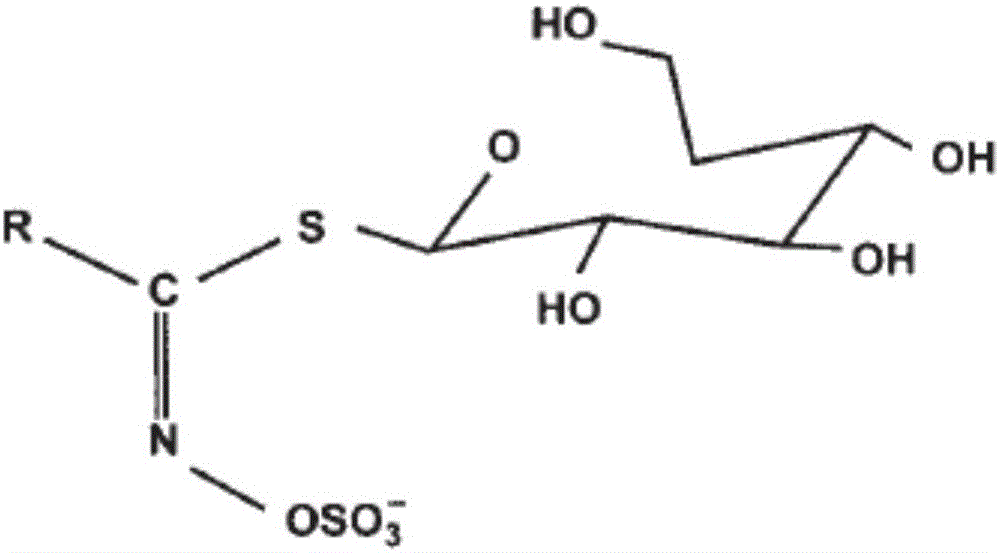Extraction and separation method of glucosinolate
A technology of glucosinolate and glucoside, which is applied in the field of extraction and separation of glucosinolate preparation, can solve the problems of incomplete deactivation of enzymes, complex desalination process, complicated experiments, etc., achieves good promotion prospects, good purification effect, The effect of high extraction efficiency
- Summary
- Abstract
- Description
- Claims
- Application Information
AI Technical Summary
Problems solved by technology
Method used
Image
Examples
Embodiment 1
[0024] Raw material pretreatment: crush 200 g of broccoli seeds whose GRA content (mass percentage content, the same below) is 4.01%, to obtain 200 g of broccoli seed powder.
[0025] Glucosinolate extraction: Take 2.3L of deionized water and heat it. After boiling, add the above-mentioned broccoli seed powder to it, extract with boiling water for 10 minutes, and filter through a filter cloth to obtain the GRA water extract. The extraction was repeated once, and the GRA water extract was collected, and the extraction rate of GRA was 98.61%.
[0026] Glucosinolate purification: Concentrate the above-mentioned GRA water extract to 2.3L, add it to 115g of activated carbon, and stir and adsorb at 25°C for 30min. Use an activated carbon filter for solid-liquid separation to obtain GRA-adsorbed activated carbon, add 2.3L of 10% ethanol aqueous solution, adjust the pH to 10.0, and elute at 25°C for 30min, repeat the elution once, and collect the GRA eluate. Spin the above-mentioned ...
Embodiment 2
[0028] Raw material pretreatment: 100 g of broccoli seeds with a GRA content of 6.72% were pulverized to obtain 200 g of broccoli seed powder.
[0029] Glucosinolate extraction: Take 1.9L of deionized water and heat it. After boiling, add the above-mentioned broccoli seed powder to it, extract with boiling water for 10 minutes, and filter through a filter cloth to obtain the GRA water extract. The extraction was repeated once to collect the GRA water extract, and the GRA extraction rate was 98.56%.
[0030] Glucosinolate purification: Concentrate the above GRA water extract to 1.9L, add it to 95g of activated carbon, and stir and adsorb at 25°C for 30min. Use an activated carbon filter for solid-liquid separation to obtain GRA-adsorbed activated carbon, add 1.9L of 10% ethanol aqueous solution, adjust the pH to 10.0, and elute at 25°C for 30min, repeat the elution once, and collect the GRA eluate. The above-mentioned GRA eluent was spin-dried, and 1.9 L of deionized water was...
Embodiment 3
[0032] Raw material pretreatment: 200 g of certain broccoli seeds with a GRA content of 3.47% were pulverized to obtain 200 g of broccoli seed powder.
[0033] Glucosinolate extraction: Take 2.0L of deionized water and heat it. After boiling, add the above-mentioned broccoli seed powder to it, extract with boiling water for 10 minutes, and filter through a filter cloth to obtain the GRA water extract. The extraction was repeated once to collect the GRA water extract, and the GRA extraction rate was 96.98%.
[0034] Glucosinolate purification: Concentrate the above GRA water extract to 2.0L, add it to 100g of activated carbon, and stir and adsorb at 25°C for 30min. Use an activated carbon filter for solid-liquid separation to obtain GRA-adsorbed activated carbon, add 2.0L of 10% ethanol aqueous solution, adjust the pH to 10.0, and elute at 25°C for 30min, repeat the elution once, and collect the GRA eluate. Spin the above-mentioned GRA eluent to dryness, add 2.0L of deionized ...
PUM
| Property | Measurement | Unit |
|---|---|---|
| adsorption capacity | aaaaa | aaaaa |
Abstract
Description
Claims
Application Information
 Login to view more
Login to view more - R&D Engineer
- R&D Manager
- IP Professional
- Industry Leading Data Capabilities
- Powerful AI technology
- Patent DNA Extraction
Browse by: Latest US Patents, China's latest patents, Technical Efficacy Thesaurus, Application Domain, Technology Topic.
© 2024 PatSnap. All rights reserved.Legal|Privacy policy|Modern Slavery Act Transparency Statement|Sitemap

